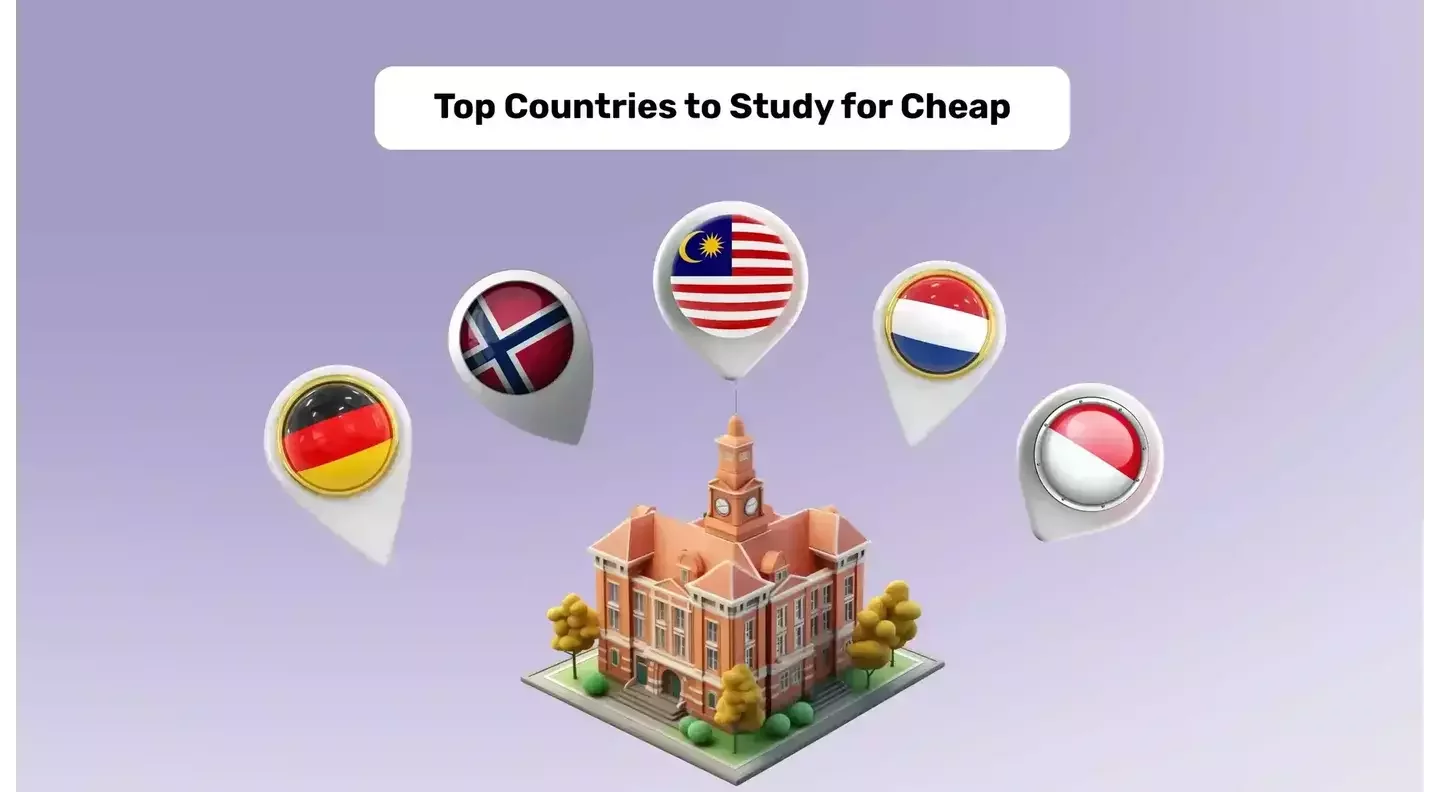Get instant loan offer suitable to your profile !


On this Page:
How to study abroad with no money? You can get the answer to this question in this blog.
Are you also searching for " How to study abroad without money?". Then you are in the right place. In this blog, we are going to help you study abroad without education loan. This information will open the door to global perspectives, enhanced career prospects, and personal growth.
The one thing that students often miss out on is that many universities and countries provide education at free of cost or at minimal cost. However, some countries are also leveraging alternative funding options. So, embark on your international education journey in the most budget-friendly countries.

Before we start with the funding option to study abroad, and avoid study abroad without education loan. Some factors contributing to the high cost of international education are as follows:
International students are charged premium rates as they contribute a major percentage to the economic growth.
Accommodation, food, transportation, and healthcare are expensive compared to India, as the majority of the popular countries are developed countries.
Student visa application fees, mandatory health insurance, and related administrative costs add up.
Flights back home during holidays and initial relocation expenses can be substantial.
Forex rates can unexpectedly increase your budget requirements.

The world is bigger than we can imagine; however, students only know about some popular countries like Canada, UK, US, and Australia. But choosing the right country can reduce your overall costs. Some of the most affordable destinations in 2025 include:
Germany is gaining popularity among students as they are providing a quality education at moderate prices. The public universities of Germany, such as the Technical University of Munich and Heidelberg University, charge zero tuition fees for both domestic and international students.
However, if universities ask for the tuition fee, then they are required to pay nominal charges of EURO 250-350 per semester. The amount includes administrative costs, public transportation passes, and access to campus amenities.
All public universities in Norway waive tuition fees for students of any nationality. However, living expenses in cities like Oslo and Bergen are high, but the absence of tuition fees makes the overall cost affordable.
Norwegian universities, such as the University of Oslo and the Norwegian University of Science and Technology, provide courses in English. The Norwegian universities provide student support services and extensive scholarship opportunities that help you rest of the educational expenses.
France combines affordability and experience to provide exquisite experiences to the students. In France, the public universities charge minimal fees under EURO 500 per year for bachelor’s programs and under EURO 700 for master’s programs.
Additionally, the French government and many institutions offer scholarships, merit-based grants, and tuition waivers for international students. So, to experience quality education, consider exploring the scholarships provided by the government and universities to students.
Poland has become an increasingly popular destination for cost-conscious students. It has universities such as Jagiellonian University and the University of Warsaw that deliver courses in English.
Also, international tuition fees range from USD 2,000 to USD 4,000 per year. The cost of living in cities like Kraków and Warsaw averages USD 500–700 per month. They also offer a variety of scholarships and work-study options to further reduce your expenses.
Malaysia is a blend of low tuition and affordable living, making it an affordable option for students. Public universities charge between USD 3,000 and USD 6,000 per year, and one can expect monthly living costs around USD 400 to USD 600 in Kuala Lumpur.
The University of Malaya and Universiti Kebangsaan Malaysia are just two examples of institutions with strong international partnerships, diverse student communities, and scholarship programs to ease financial burdens.

Countries sometimes tend to be difficult to evaluate; thus, here is a list of the universities where you can study abroad without education loan.
Argentina’s largest and a prestigious institution, the University of Buenos Aires (UBA), offers free tuition for both domestic and international students. To get admission, students need to pay a small administrative fee of about USD 50–100 per year. This cost covers registration and access to libraries and labs. UBA is in Latin America for research in medicine, law, and social sciences. However, the classes are primarily in Spanish, so proficiency is required, but some postgraduate programs offer courses in English.
Freie Universität Berlin is a German research university that charges no tuition fees for undergraduate or postgraduate degrees. Instead, students pay a semester contribution of EURO 300–350, which includes a public transit pass, administrative services, and cultural activities. The campus is spread across Berlin’s Dahlem quarter, and the university offers a wide range of English-taught master’s programs in the humanities, natural sciences, and social sciences.
As Poland’s largest university, the University of Warsaw offers many programs in English, especially at the postgraduate level. International students can expect tuition fees between USD 2,500 and USD 3,500 per year. The university also provides merit-based scholarships covering tuition and living stipends. They also provide affordable on‑campus housing options in the city center. However, a student can also expect low living costs in Warsaw of around USD 600–800 per month. Thus, making it an attractive choice.
Established in 1365, the University of Vienna is one of Europe’s oldest institutions. EU/EEA students study tuition-free, while non‑EU students pay a modest fee of EUR 1,453 per year. This coverage includes all academic resources and student services. The university offers programs in English across disciplines such as business, international relations, and natural sciences, and sits in the heart of Vienna.
NTNU is Norway’s leading technical university, with no tuition fees for any nationality. They asl for a nominal fee of around USD 60 for a semester. This amount covers student welfare services. Other than this, the living costs in Norway are about USD 1,200 to 1,500, making it a generous and manageable expense. Students can enroll in the engineering, architecture, and entrepreneurship programs.
UNAM is Latin America’s largest university, renowned for its research output. The international students pay an annual tuition fee of USD 1,000–3,000. They also provide on-campus housing at very low rates and numerous scholarships based on academic merit. However, students can expect the Mexico City’s monthly living expenses average around USD 700–900.

After seeing the expected amount in some universities, you are still stuck on the question, "How to study abroad with no money?" Then here is the answer: Use a solid budget roadmap to study abroad debt-free:










If you are somehow not able to get into these universities or have some part of the expenses that need to be arranged, then go for these alternative options:







Study abroad without education loan is entirely possible in 2025; this just depends on the university and country you are targeting. Suppose you choose cost-effective destinations like Germany, Norway, or Poland and enroll in institutions where you don't need to pay the tuition fee, then you can afford your studies abroad. However, to cover your living costs, you can take advantage of scholarships, assistantships, and part-time work. Still, if you feel that you might need to arrange funds for your studies abroad, then go and check your loan eligibility with GyanDhan to explore financing solutions that complement your debt-free plan and make your overseas education dreams a reality.

Scholarships, grants, fellowships/assistantships, part-time work, employer sponsorships, and crowdfunding.
Yes, programmes like DAAD (Germany), Chevening (UK), Fulbright, Erasmus Mundus, Taiwan Scholarship, and university-specific awards.
List all expenses, set a realistic monthly cap, track spending, choose shared housing, cook at home, and build an emergency fund.
On-campus roles (libraries, labs), research/teaching assistantships, retail or hospitality, and paid internships via co-op programmes.
It can help cover gaps, and the success depends on a compelling pitch and a strong network, but it rarely pays 100% of the costs.
Combine low-tuition destinations, scholarships, tight budgeting, part-time work, and crowdfunding to spread costs and avoid debt.
Check Your Education Loan Eligibility

Ask from a community of 10K+ peers, alumni and experts
Trending Blogs
Similar Blogs

Network with a community of curious students, just like you
Join our community to make connections, find answers and future roommates.. Join our CommunityCountry-Wise Loans
Best Lenders for Education Loan

ICICI Bank

Axis Bank

Union Bank

Prodigy

Auxilo

Credila

IDFC

InCred

MPower

Avanse

SBI

BOB

Poonawalla

Saraswat